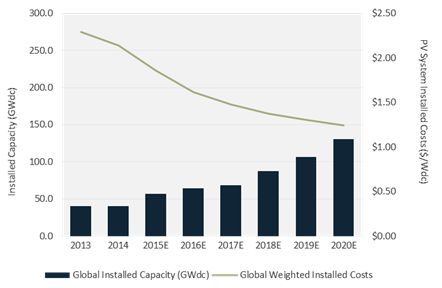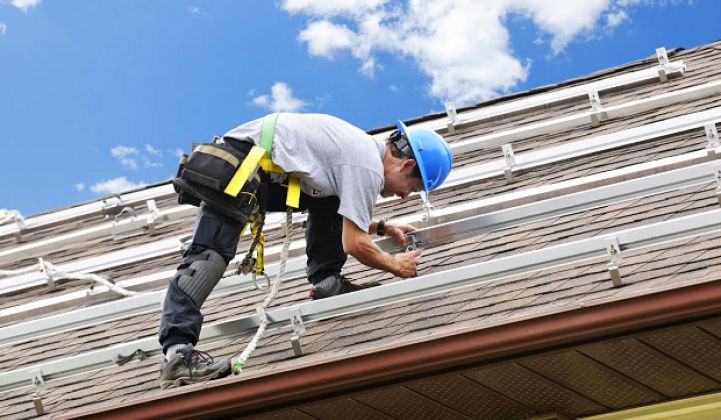According to GTM Research’s latest report, PV Balance of Systems 2015: Technology Trends and Markets in the U.S. and Abroad, average global PV system installed costs will fall from $2.16 per watt in 2014 to $1.24 per watt by 2020, a 40 percent decline. Costs will continue to vary by region and market segment, but a combination of balance-of-system innovations will drive cost reductions across the board and ultimately fuel the global solar market to move well past 100 gigawatts by 2020.
FIGURE: Global Installed Capacity and Average PV System Installed Costs, 2013-2020E

Source: GTM Research’s PV Balance of Systems 2015
The report notes that balance-of-system (BOS) costs have come down tremendously. Between 2007 and 2014, BOS costs decreased between 39 percent and 64 percent, depending on market segment and geography. However, BOS cost reductions are not keeping pace with those of modules. For an average U.S. residential solar PV system, BOS costs account for 77 percent of the total installed costs. That’s up significantly from 2007, when BOS costs represented 58 percent and modules made up the remaining 42 percent.
“While declining module costs remain important, innovations in PV power electronics, structural hardware, installation processes, and the integration of PV systems as a whole will be the primary push toward more economically competitive solar in the wake of waning global incentives,” states report author MJ Shiao.
In addition to providing detailed, segmented PV system installed costs and market forecasts, the report outlines how U.S. and global companies are reducing costs for structural and electrical equipment, PV power electronics, installation labor, design and engineering, and customer acquisition. The report walks through key technology evolutions driving reduced costs across all market segments, including the effects of increased module efficiency, distributed PV power electronics, rail-free racking, east-west systems, 1,500 Vdc systems, and one-axis tracking.
“In the solar market of the future, the PV industry can no longer depend on a silver bullet to reduce total system costs. Rather, vendors and installers must look toward the combination of several technology, system design and process improvements to drive increased PV performance at decreased costs,” states Shiao. “While new concepts like rail-free racking or 1,500 Vdc grab the most attention, mundane improvements such as reduced structural foundations or installation-labor compensation strategies are also important considerations for cost reduction.”
Despite rapidly falling costs, GTM Research expects the global PV BOS market -- including all non-module hardware and soft-cost components -- to be valued at $100 billion by 2020.
For more information, download the report brochure here.
***
MJ Shiao will be presenting additional findings from the report at the U.S. Solar Market Insight Conference in November. See the full agenda and register here.



